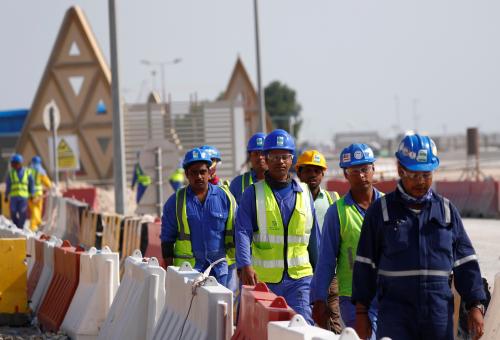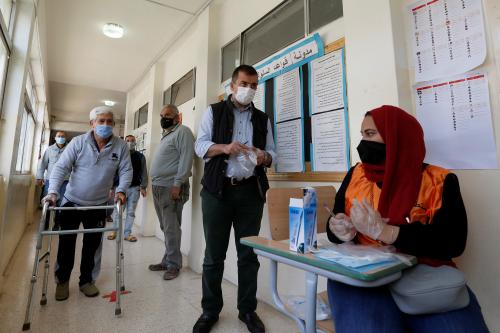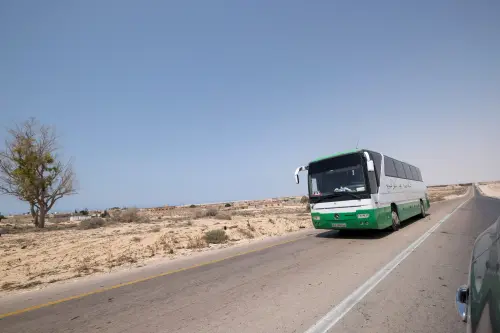Content from the Brookings Doha Center is now archived. In September 2021, after 14 years of impactful partnership, Brookings and the Brookings Doha Center announced that they were ending their affiliation. The Brookings Doha Center is now the Middle East Council on Global Affairs, a separate public policy institution based in Qatar.
As power shifts in Iraq and alliances are formed and dismantled from battle to battle, much has been written about the threats and perils posed by Shiite militias in the unfolding events. But the objectives of those militias and their evolution in the Iraqi context remain clouded in a veil of confusion. Brookings Doha Center Fellow Ranj Alaaldin recently visited Iraq to research Iraq’s Shiite militias and sat down with Communications Assistant Sumaya Attia to discuss the topic.
Sumaya Attia (SA): It is almost impossible to speak about Iraq’s political landscape without mentioning the Shiite militias, but that wasn’t always the case. Under what circumstances were these groups formed?
Ranj Alaaldin (RA): Iraq’s Shiite militias are a product of the destitution and Baath brutality of the 1990s and the disorder and violence of post-2003 Iraq. The political outlook and consciousness of the fighters that comprise the militia groups today developed in the 1990s, when the 1991 uprising unfolded and failed, Saddam decimated Iraq’s Shiite community, and destitution followed.
Put simply, yesterday’s Shiite activists have become today’s Shiite militias. Unlike the ecumenical, intellectual, and reformist outlook of the Shiite activists that established the Islamic Dawa Party in the 1950s (Iraq’s ruling party and the first modern Shiite Islamist socio-political movement), Iraq’s Shiites became increasingly violent, radical, and sectarian under the Baath regime’s rule. Their objectives centered on political and social justice, sectarian grievances, and poverty alleviation.
Shiite militias today are made up of different factions with independent identities that nevertheless constitute components of a collective movement. This movement is united in its grievances, sense of victimhood, and objectives. It aims to prevent a Baathist resurrection (which is how it frames the emergence of ISIS) and to maintain the post-2003 political order in which Shiites wield power and authority.
(SA): You were in Iraq recently; can you tell us about the purpose of your trip?
(RA): The purpose of my trip was to assess Iraq’s crisis of governance and authority. In addition to exploring questions regarding the state of Iraqi politics, the future of Iraq, and the prospects for a Kurdish state, I also looked into Iraq’s Shiite militias and the Hashd al-Shaabi. I had a chance to speak to representatives of the different groups that comprise the Hashd al-Shaabi, in addition to various militia heads, politicians, and ordinary Iraqi citizens.
Understanding these militias, their interactions with the state and society, and their fundamental perceptions about themselves and their place in Iraq requires extensive fieldwork. It also demands an appreciation of the historical context of Shiite activism in Iraq and the developments that have taken place since 2003. Dialogue with militias is necessary to better formulate realistic policy-recommendations regarding those groups.
SA: How have the Shiite militias been empowered in recent years?
RA: Iraq struggled with Shiite militias for the past decade. However, recently the security vacuum that followed the emergence of ISIS has strengthened those pre-existing, battle-hardened Shiite militias. This could have far-reaching consequences for the Iraqi state and the fabric of the Iraqi society in coming years. Once opportunistic criminal groups, these actors recently became institutionalized into the Iraqi state and many have little regard for human rights and international norms.
We see this in conflict zones throughout the world; it is armed groups that emerge to fill the vacuum that results from state collapse or institutional failure, often leading to disastrous consequences for stabilization and reconstruction. While such actors may have popular support and legitimacy, their presence, conduct, discourse, and objectives undermine stability and good governance and are not conducive to co-existence and reconciliation. Shiite militias are less inclined and qualified to engage in the business of governance as they are used to operating in the spheres of armed conflict and the underground economy that comes with it.
SA: You mentioned that today’s Shiite militias are made up of a cluster of different factions. How did all the various groups emerge?
RA: After the collapse of the state, hundreds of thousands of Shiites had no jobs or access to public services. Their communities faced incessant attacks from local and foreign terrorist groups, remnants of the Baath regime, and, from their perspective, occupying Western powers.
From this crisis of security and governance emerged the Mahdi Army (renamed the Peace Brigade). The brigade is the armed wing of the Sadrist movement, which was established in the 1990s by Mohammad Sadeq al-Sadr and is currently led by his son, Muqtada Al-Sadr. The Mahdi Army was ill-prepared for the twin-burden of administration and rebellion. While both the movement and the brigade are centered around Al-Sadr’s leadership, they were operationally decentralized. During the course of the conflict, Mahdi Army commanders acquired their own popular support, and eventually, headed their own splinter groups with backing from Iran.
The Badr Brigade (established in the 1980s by Iran) is another good example of the complexities that define the militia groups. This organization is Iraq’s most powerful militia because of its size, its history, and its integration into the post-2003 political order. It controls Iraq’s largest ministry, the Interior Ministry, and has engaged with the international community despite its strong ties to Iran.
Other militias are Iranian proxies established as offshoots of the Sadrist movement or the Badr Brigade. Despite being a nuisance, those often struggle to develop into prominent socio-cultural movements. While some, like Asaib ahl al-Haq (a Sadrist offshoot), are more organized and have established themselves as socio-cultural actors that are heavily aligned with Iran.
SA: What is Iran’s strategy in Iraq and how is it using its militia proxies to further its own interests?
RA: Iran’s strategy in Iraq is multi-faceted but essentially one of divide and conquer. Where grievances and factures emerged within the Sadrist movement and other groups, Iran stepped in to offer weapons, money, and training. After the 2003 invasion, it worked with former Badr Brigade commanders to establish proxies that would later capitalize on the rising violence and sectarian conflict. Some of these proxies are spearheading the Hashd al-Shaabi militia that has recently been institutionalized, functioning parallel to the much weaker Iraqi military.
Overall, Shiite militia proxies act as a button and a buffer. They are a button that Iran can press to indirectly confront, intimidate, eliminate, or injure those actors that threaten its interests. On the other hand, they act as a buffer that allows Iran to distance itself from the situation. Specifically, thanks to those militias, any violations of international norms and human rights are not linked directly to Iran, allowing it to maintain a positive image both regionally and internationally.
SA: How does this explain Iran’s involvement in Iraq?
RA: Iraq is a neighboring country that was at war with Iran for almost a decade. The Iranians that are spearheading Iran’s foreign policy for Iraq are veterans of the Iran-Iraq war that now dominate the IRGC. Iraq always had the potential to confront, sideline, or weaken Iran. Iran wants to make sure that Iraq is never again in a position to threaten its national security, and most importantly, aims to prevent Iraq from becoming a launching pad for an invasion of its territories.
Conversely, Iran wants Iraq to be a launching pad for its own regional interests and for conflicts like the one unfolding in Syria. Iran has aimed to establish Iraq as a key pillar of its regional security architecture. It has done so very successfully; while once encircled by strong and stable Arab governments with immense resources and Western allies, the outlook of Iran’s neighborhood has been reversed over the past ten-years.
SA: After the liberation of Mosul, how should the international community deal with Iraq’s Shiite militias? What role will they have in Iraq and the region?
RA: To understand and deal with Shiite militias in Iraq, it is first important to look at these groups beyond the militant, criminal, Iranian proxy paradigm often used to define and characterize them. This framework does not only lead to misplaced analyses but also exaggerates Iranian influence in a way that serves Iran. Any movement forward would require a holistic approach that appreciates the communal, grassroots dynamics within the Shiite community.
Put in simple terms, there are good militias and bad militias. The former should be empowered. They are often weaker than the bad militias that tend to be aligned with Iran and disregard human rights and international norms. I will discuss this in length in my forthcoming policy briefing.
The Brookings Institution is committed to quality, independence, and impact.
We are supported by a diverse array of funders. In line with our values and policies, each Brookings publication represents the sole views of its author(s).




Commentary
Op-edShiite militias in Iraq: Why context matters
May 11, 2017